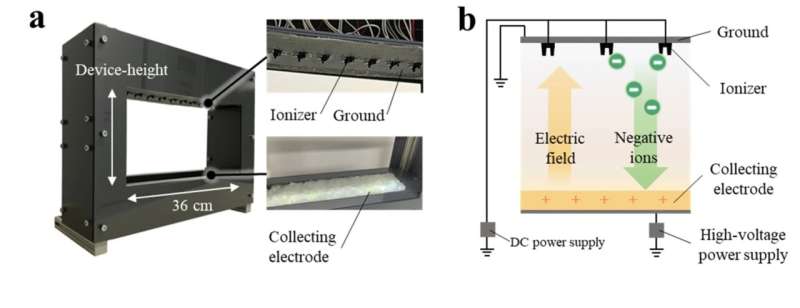This article has been reviewed according to Science X's editorial process and policies. Editors have highlighted the following attributes while ensuring the content's credibility:
fact-checked
peer-reviewed publication
trusted source
proofread
Using ions and an electric field to prevent airborne infection without impeding communication

A novel device developed by researchers from Tokyo Institute of Technology, Tokyo Medical and Dental University, and Chiba University in a new study utilizes ions and an electric field to effectively capture infectious droplets and aerosols, while letting light and sound pass through to allow communication. The innovation is significant in the wake of the COVID-19 pandemic, since it shows promise in preventing airborne infection while facilitating communication.
Airborne infections, such as H1N1 influenza, SARS, and COVID-19, are spread by aerosols and airborne droplets. While the droplet/aerosol transmission can be prevented using acrylic partitions or, as with the COVID-19 pandemic, by imposing lockdowns in severe cases, these countermeasures can significantly impede communication. This, in turn, can lead to unintended consequences.
For instance, lockdown measures during the COVID-19 pandemic led to severe economic losses as well as a rise in cases of mental illness like depression and suicide around the world. Therefore, as we prepare for a potential future pandemic, it is necessary to develop more sustainable countermeasures that do not disrupt economic activities and daily face-to-face interactions.
To this end, a research team including Kaito Kanda, a graduate student at Tokyo Institute of Technology (Tokyo Tech) at the time of research, Assistant Professor Tetsuya Yamada, from the Institute of Innovative Research at Tokyo Tech, and Professor Takeo Fujiwara from Tokyo Medical and Dental University (TMDU) and Chiba University researchers, has now developed a device that successfully captures droplets and aerosols while allowing the transmission of light and sound for effective communication.
Their work, which presents a novel solution for preventing the transmission of airborne pathogens, including the coronavirus, was published in Scientific Reports on 26 August 2023.
"While traditional partitions play a role in preventing airborne infection, they have been known to obstruct smooth communication by affecting the visibility of facial expressions and blocking voices. Recognizing these issues after experiencing limitations in communicating with my grandfather in a partitioned meeting area at a nursing home, we decided to tackle the challenge of reconciling airborne infection prevention and communication," explains Mr. Kanda.
Subsequently, during a symposium hosted by the Consortium for Post COVID-19 Society in 2021, students and researchers from the union of four universities in Tokyo, including Tokyo Medical and Dental University, Tokyo University of Foreign Studies, Tokyo Institute of Technology, and Hitotsubashi University, engaged in a group discussion concluded that partitions should be further improved.
The students in the group had created a prototype for new partitions at Tokyo Tech, and researchers from the TMDU, actively involved in COVID treatment, conducted validation experiments in the clinic.
To enable unimpeded communication, a device must allow the transmission of sound and light. At the same time, it must capture the sources of infection, i.e., airborne droplets and aerosols. The researchers found a solution by harnessing pre-existing ion and electric field-based aerosol capture technologies utilized in air purifiers.
"As a verification step, we first captured incense smoke near an ion and electric field generator. In regions where no ions or electric field were present, the smoke rose naturally, while it was drawn downward in places where the device was operational," adds Dr. Yamada.
It was also critical to ensure that the ions and electric field did not hinder the transmission of sound and light. Notably, conventional six-mm-thick acrylic panels used in partitions reflect light, limiting the perception of facial expressions during conversation.
In contrast, ions and electric field demonstrated high light transmittance—equivalent to that of air. Similarly, while acrylic panels interfered with sound, ions and electric field allowed sound to pass through like air. These results showed that ions and electric field enabled the transmission of light and sound while capturing aerosols.
Encouraged by these results, the researchers created a device that generates ions and an electric field. The ozone concentration generated in it was below 0.001 ppm, and the electric field strength at a distance of 30 cm from the device ranged from 10–45 kV, undetectable by humans.
By introducing aerosols simulating a light cough to the proposed device, the team demonstrated that it could block 89% of the droplets at an opening height of 16 cm. Finally, a prototype was installed in hospital rooms where patients infected with COVID-19 had been admitted. "The device successfully captured aerosols, including the coronavirus, reducing the viral load in the room," says Prof. Fujiwara.
The present study demonstrates the effectiveness of the newly developed device in blocking out droplets and aerosols while allowing for communication.
More information: Kaito Kanda et al, Applying negative ions and an electric field to countermeasure droplets/aerosol transmission without hindering communication, Scientific Reports (2023). DOI: 10.1038/s41598-023-40303-5



















